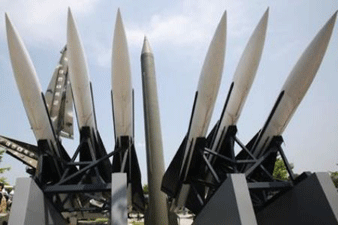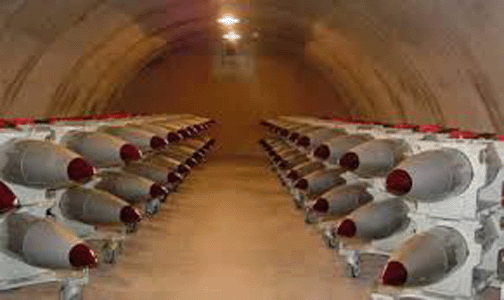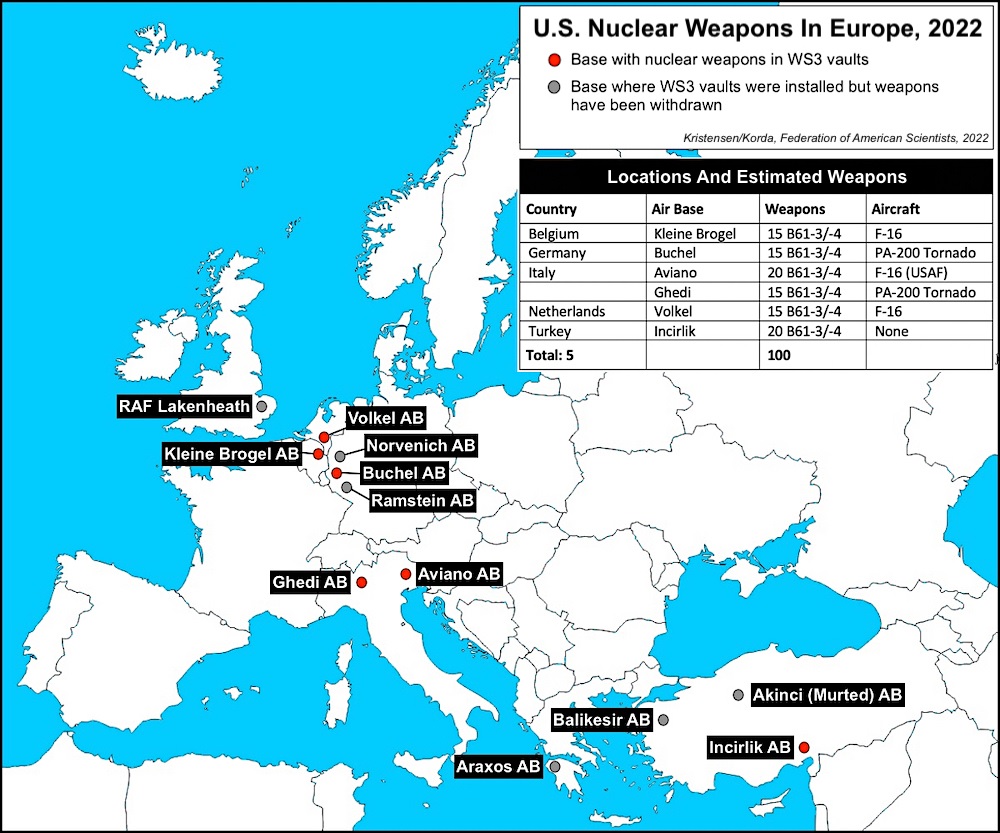United States nuclear weapons, 2024

The current strategic nuclear war plan—OPLAN 8010–12—consists of “a family of plans” directed against four identified adversaries: Russia, China, North Korea, and Iran.
Just like previous NPRs, the Biden administration’s NPR said the United States reserved the right to use nuclear weapons under “extreme circumstances to defend the vital interests of the United States or its allies and partners” and rejected policies of nuclear “no-first-use” or “sole purpose” (US Department of Defense 2022a, 9)
Bulletin, By Hans M. Kristensen, Matt Korda, Eliana Johns, Mackenzie Knight | May 7, 2024
The United States has embarked on a wide-ranging nuclear modernization program that will ultimately see every nuclear delivery system replaced with newer versions over the coming decades. In this issue of the Nuclear Notebook, we estimate that the United States maintains a stockpile of approximately 3,708 warheads—an unchanged estimate from the previous year. Of these, only about 1,770 warheads are deployed, while approximately 1,938 are held in reserve. Additionally, approximately 1,336 retired warheads are awaiting dismantlement, giving a total inventory of approximately 5,044 nuclear warheads. Of the approximately 1,770 warheads that are deployed, 400 are on land-based intercontinental ballistic missiles, roughly 970 are on submarine-launched ballistic missiles, 300 are at bomber bases in the United States, and approximately 100 tactical bombs are at European bases. The Nuclear Notebook is researched and written by the staff of the Federation of American Scientists’ Nuclear Information Project: director Hans M. Kristensen, senior research fellow Matt Korda, research associate Eliana Johns, and program associate Mackenzie Knight.

In May 2024, the US Department of Defense maintained an estimated stockpile of approximately 3,708 nuclear warheads for delivery by ballistic missiles and aircraft. Most of the warheads in the stockpile are not deployed but rather stored for potential upload onto missiles and aircraft as necessary. We estimate that approximately 1,770 warheads are currently deployed, of which roughly 1,370 strategic warheads are deployed on ballistic missiles and another 300 at strategic bomber bases in the United States. An additional 100 tactical bombs are deployed at air bases in Europe. The remaining warheads—approximately 1,938—are in storage as a so-called “hedge” against technical or geopolitical surprises. Several hundred of those warheads are scheduled to be retired before 2030 (see Table 1 on original).
While the majority of the United States’ warheads comprises the Department of Defense’s military stockpile, retired warheads under the custody of the Department of Energy awaiting dismantlement constitute a “significant fraction” of the United States’ total warhead inventory (US Department of Energy 2023b). Dismantlement operations include the disassembly of retired weapons into component parts that are then assigned for reuse, storage, surveillance, or for additional disassembly and subsequent disposition (US Department of Energy 2023b, 2–11). The pace of warhead dismantlement has slowed significantly in recent years: While the United States dismantled on average more than 1,000 warheads per year during the 1990s, in 2020 it dismantled only 184 warheads (US State Department 2021). According to the Department of Energy, “[d]ismantlement rates are affected by many factors, including appropriated program funding, logistics, legislation, policy, directives, weapon system complexity, and the availability of qualified personnel, equipment, and facilities” ……………………………………..
…………….. we estimate that the United States possesses approximately 1,336 retired—but still intact—warheads awaiting dismantlement, giving a total estimated US inventory of approximately 5,044 warheads.
Between 2010 and 2018, the US government publicly disclosed the size of the nuclear weapons stockpile; however, in 2019 and 2020, the Trump administration rejected requests from the Federation of American Scientists to declassify the latest stockpile numbers (Aftergood 2019; Kristensen 2019a, 2020b). In 2021, the Biden administration restored the United States’ previous transparency levels by declassifying both numbers for the entire history of the US nuclear arsenal until September 2020—including the missing years of the Trump administration. . This effort revealed that the United States’ nuclear stockpile consisted of 3,750 warheads in September 2020—only 72 warheads fewer than the last number made available in September 2017 before the Trump administration reduced the US government’s transparency efforts (US State Department 2021). We estimate that the stockpile will continue to decline over the next decade as modernization programs consolidate the remaining warheads.
Following the Biden administration’s initial declassification in 2021, it has since denied successive annual requests from the Federation of American Scientists to disclose the stockpile numbers for 2021, 2022, or 2023 (Kristensen 2023d). A decision to no longer declassify these numbers not only contradicts the Biden administration’s own recent practices, but also represents a return to Trump-era levels of nuclear opacity. Such increased nuclear secrecy undermines US calls for Russia and China to increase transparency of their nuclear forces.

The US nuclear weapons are thought to be stored at an estimated 24 geographical locations in 11 US states and five European countries (Kristensen and Korda 2019, 124). The number of locations will increase over the next decade as nuclear storage capacity is added to three bomber bases. The location with the most nuclear weapons by far is the large Kirtland Underground Munitions and Maintenance Storage Complex south of Albuquerque, New Mexico. Most of the weapons in this location are retired weapons awaiting dismantlement at the Pantex Plant in Texas. The state with the second-largest inventory is Washington, which is home to the Strategic Weapons Facility Pacific and the ballistic missile submarines at Naval Submarine Base Kitsap. The submarines operating from this base carry more deployed nuclear weapons than any other base in the United States.
Implementing the New START treaty
The United States appears to be in compliance with the New Strategic Arms Reduction Treaty (New START) limits. Although Russia “suspended” its participation in New START in February 2023, the United States publicly declared in May 2023 that it had 1,419 warheads attributed to 662 deployed ballistic missiles and heavy bombers as of March 1st, 2023 (US State Department 2023a). The United States initially said that it voluntarily released the numbers “[i]n the interest of transparency and the US commitment to responsible nuclear conduct.” However, the United States did not continue this practice beyond that initial exchange and has not published any aggregate numbers since May 2023 (US State Department 2023a)
The United States contends that Russia’s “suspension” of New START implementation is “legally invalid” (US State Department 2023c). In response, the United States adopted four countermeasures in 2023 that it claimed were fully consistent with international law 1) no longer providing biannual data updates to Russia; 2) withholding from Russia notifications regarding treaty-accountable items (i.e. missiles and launchers) required under the treaty; 3) refraining from facilitating inspection activities on US territory; and 4) not providing Russia with telemetric information on US ICBM and SLBM launches (US State Department 2023c).
The New START warhead numbers reported by the US State Department differ from the estimates presented in this Nuclear Notebook, though there are reasons for this. …………………..
Since the treaty entered into force in February 2011, the biannual aggregate data show the United States has cut its arsenal by a total of 324 strategic launchers, reduced deployed launchers by 220 and the warheads attributed to them by 381 (US State Department 2011). The warhead reduction is modest, only equivalent to about 10 percent of the 3,708 warheads remaining in the US stockpile. ………….
As of March 2023, the United States had 38 launchers and 131 warheads less than the treaty limit for deployed strategic weapons but had 119 deployed launchers more than Russia—a significant gap that is just under the size of an entire US Air Force intercontinental ballistic missile (ICBM) wing. So far Russia has not sought to reduce this gap by deploying more strategic launchers but instead has increased the portion of its missiles that can carry multiple warheads.
The New START treaty has proven useful so far in keeping a lid on both countries’ deployed strategic forces. But it expires in February 2026 and if it is not followed by a new agreement, both the United States and Russia could potentially increase their deployed nuclear arsenals by uploading several hundred of stored reserve warheads onto their launchers.
Nuclear Posture Reviews and nuclear modernization programs
The Biden administration’s 2022 Nuclear Posture Review (NPR) was broadly consistent with the Trump administration’s 2018 NPR…………………………………
Just like previous NPRs, the Biden administration’s NPR said the United States reserved the right to use nuclear weapons under “extreme circumstances to defend the vital interests of the United States or its allies and partners” and rejected policies of nuclear “no-first-use” or “sole purpose” (US Department of Defense 2022a, 9)…………………………………………………………………………………………………………………………………………………
In 2023, multiple governmental advisory commissions published reports intended to influence US nuclear posture. The Congressionally-mandated report on “America’s Strategic Posture,” published in October 2023, included a broad range of recommendations for the United States to prepare to increase the number of deployed warheads, as well as to scale up its production capacity of bombers, air-launched cruise missiles, ballistic missile submarines, non-strategic nuclear forces, and warheads (US Strategic Posture Commission 2023). It also called for the United States to deploy multiple warheads on land-based intercontinental ballistic missiles (ICBMs) and consider adding road-mobile ICBMs to its arsenal…………………………………. the Strategic Posture Commission report’s status as a bipartisan document has been particularly useful for nuclear advocates to push for additional nuclear weapons (Heritage 2023; Hudson Institute 2023; Thropp 2023).
While additional modernization programs are being discussed, the National Nuclear Security Administration, or NNSA, delivered in 2023 more than 200 modernized nuclear weapons (B61–12 bombs and W88 Alt 370 warheads) to the Department of Defense (US Department of Energy 2024).
Nuclear planning and nuclear exercises
In addition to the Nuclear Posture Review, the nuclear arsenal and the role it plays is shaped by plans and exercises that create the strike plans and practice how to carry them out.
The current strategic nuclear war plan—OPLAN 8010–12—consists of “a family of plans” directed against four identified adversaries: Russia, China, North Korea, and Iran. Known as “Strategic Deterrence and Force Employment,” OPLAN 8010–12 first entered into effect in July 2012 in response to operational order Global Citadel. ………………………………………………………………….
…………………………………. changes are evident in the types of increasingly provocative bomber operations over Europe, in some cases very close to the Russian border (Kristensen 2022a). In October 2023, for example, a B-52 bomber from Barksdale AFB in Louisiana participated in NATO’s annual nuclear exercise Steadfast Noon, and in March 2023 a nuclear-capable B-52 cut south only a few kilometers from the Russian sea border and then flew south near Kaliningrad (Kristensen 2023a; NATO 2023).
…………………US strategy has changed in response to deteriorating East-West relations and the new “great power competition” and “strategic competition” strategy promoted by the Trump and Biden administrations, respectively. They also illustrate a growing integration of nuclear and conventional capabilities, as reflected in the new strategic war plan. B-52 Bomber Task Force deployments typically include a mix of nuclear-capable aircraft and aircraft that have been converted to conventional-only missions. With Sweden joining NATO, US strategic bombers now routinely operate over Swedish territory: In August 2022, for example, two B-52s—one version that is nuclear-capable and one that is de-nuclearized—overflew Sweden, the first overflight since it applied for NATO membership in May 2022 (Kristensen 2022c)…………………………………………………………………………………………….
Land-based ballistic missiles
The US Air Force (USAF) operates 400 silo-based Minuteman III ICBMs and keeps “warm” another 50 silos to load stored missiles if necessary, for a total of 450 silos. Land-based missile silos are divided into three wings: the 90th Missile Wing at F. E. Warren Air Force Base in Colorado, Nebraska, and Wyoming; the 91st Missile Wing at Minot Air Force Base in North Dakota; and the 341st Missile Wing at Malmstrom Air Force Base in Montana. Each wing has three squadrons, each with 50 Minuteman III silos collectively controlled by five launch control centers. We estimate there are up to 800 warheads assigned to the ICBM force, of which about half are deployed (see Table 1, on original).
The 400 deployed Minuteman IIIs carry one warhead each, either a 300-kiloton W87/Mk21 or a 335-kiloton W78/Mk12A. ICBMs equipped with the W78/Mk12A, however, could technically be uploaded to carry two or three independently targetable warheads each, for a total of 800 warheads available for the ICBM force……………………………………………………………………………………….
Part of the ongoing ICBM modernization program involves upgrades to the Mk21 reentry vehicles’ arming, fuzing, and firing system at a total cost of nearly $1 billion (US Department of Defense 2023c, 32). The publicly stated purpose of this refurbishment is to extend the vehicles’ service lives, but the effort appears to also involve adding a “burst height compensation” to enhance the targeting effectiveness of the warheads (Postol 2014)………………………………………………………………………………. As part of the Mk21A program, Lockheed Martin was awarded a sole source contract in October 2023 amounting to just under $1 billion for the engineering and manufacturing of the new reentry vehicle (US Department of Defense 2023b). These modernization efforts complement a similar fuze upgrade underway to the Navy’s W76–1/Mk4A warhead.
………………………………………………………………………………………………………………….. The Air Force’s FY24 budget for ICBM Reentry Vehicles Research Development, Test & Evaluation Programs increased significantly from the previous President’s Budget……………………………………………………………………………..
…………………………….Non-governmental experts, including those conducting Department of Defense-sponsored research, have questioned the Pentagon’s procurement process and lack of transparency regarding its decision to pursue the Sentinel option over other potential deployment and basing options (Dalton et al. 2022, 4). Moreover, it is unclear why an enhancement of ICBM capabilities would be necessary for the United States. For instance, any such enhancements would not mitigate the inherent challenges associated with launch-on-warning, risky territorial overflights, or silo vulnerabilities to environmental catastrophes or conventional counterforce strikes (Korda 2021). Additionally, even if adversarial missile defenses improved significantly, the ability to evade missile defenses lies with the payload—not the missile itself. ………………………………………..
……………………………………………….The development of the Sentinel has also been marked by a series of controversial industry contracts, starting with the awarding of a $13.3 billion sole-source contract to Northrop Grumman in 2020 to complete the engineering and manufacturing development stage
…………………………………………..in early 2024, the Air Force notified Congress of a two-year delay in the schedule and an estimated 37-percent increase from the current cost target to at least $125 billion (Tirpak 2024). These amounts do not include the costs for the new Sentinel warhead—the W87–1—which is projected to cost up to $14.8 billion, or the plutonium pit production that the US Air Force and US Strategic Command say is needed to build the warheads (Government Accountability Office 2020).
…………………………………………The schedule and extreme cost overruns for the Sentinel program incurred a critical breach of the Nunn-McCurdy Act, which requires the Secretary of Defense to conduct a root-cause analysis and renewed cost assessment before providing a certification to Congress that verifies the necessity and viability of the program no later than 60 days after a Selected Acquisition
…………………………………………………..Andrew Hunter, Assistant Secretary of the Air Force for Acquisition, Technology, and Logistics clarified that while the cost of the missile itself has increased, challenges with supporting infrastructure is the significant driver of schedule overrun, which also further impacts the overall cost (Tirpak 2024). In addition to an entirely new missile, the Sentinel program includes launch facility replacement and modifications (since the Sentinel may require a larger silo), new missile alert facilities, and new command and control facilities and systems—not to mention new training and curriculum for USAF personnel. Many of these delays are results of staffing shortfalls, clearance delays, IT infrastructure challenges, and trouble with supply chains on the part of Northrop Grumman (Government Accountability Office 2023a, 88)………………………………………………………………………………………………………………………………………………………………………..
Nuclear-powered ballistic missile submarines
The US Navy operates a fleet of 14 Ohio-class ballistic missile submarines (SSBNs), of which eight operate in the Pacific from their base near Bangor, Washington, and six operate in the Atlantic from their base at Kings Bay, Georgia……………………………………………………………………………………………..
Each submarine can carry up to 20 Trident II D5 sea-launched ballistic missiles
……………………………………………………………………………………………………………………Design of the next generation of ballistic missile submarines, known as the Columbia-class, is well underway.
………………………………………..the Navy’s fiscal 2024 budget submission estimated the procurement cost of the first Columbia-class SSBN—the USS District of Columbia (SSBN-826)—at approximately $15.2 billion, followed by $9.3 billion for the second boat (Congressional Research Service 2024, 9). A $5.1 billion development contract was awarded to General Dynamics Electric Boat in September 2017, and construction of the first boat began on October 1, 2020—the first day of FY 2021………………………………………………………..
…………………According to a June 2023 report by the Government Accountability Office, “the program remains behind on producing design products—in particular, work instructions that detail how to build the submarine—because of ongoing challenges using a software-based design tool. These, in turn, contributed to delays in construction of the lead submarine” (Government Accountability Office 2023a, 160). The Navy is working to mitigate additional delays, but these constraints mean that the program is at significant risk of cost overgrowth and is very likely to suffer further setbacks………………………………………………………………………………..
Strategic bombers
The US Air Force currently operates a fleet of 20 B-2A bombers (all of which are nuclear-capable) and 76 B-52 H bombers (46 of which are nuclear-capable)……………………………………………………………Each B-2 can carry up to 16 nuclear bombs (the B61–7, B61–11, B61–12, and B83–1 gravity bombs)…………..An estimated 788 nuclear weapons, including approximately 500 air-launched cruise missiles, are assigned to the bombers, but only about 300 weapons are thought to be deployed at bomber bases (see Table 1). The estimated remaining 488 bomber weapons are thought to be in central storage at the large Kirtland Underground Munitions Maintenance and Storage Complex outside Albuquerque, New Mexico.
The United States is modernizing its nuclear bomber force by upgrading nuclear command-and-control capabilities on existing bombers, developing enhanced nuclear weapons (the B61–12, B61–13, and the new AGM-181 Long-Range Standoff Weapon or LRSO), and designing a new heavy bomber (the B-21 Raider).
Upgrades to the nuclear command-and-control systems that the bombers use to plan and conduct nuclear strikes include the Global Aircrew Strategic Network Terminal (ASNT)…………………………………………………………………………………………………………….
The United States was initially expected to produce approximately 480 B61–12 bombs, but in 2023 it announced that a small number of them instead will be produced as the B61–13, a gravity bomb with a much larger yield (US Department of Defense 2023e………………………………………………………………………………………………………………
The Air Force is also developing a new nuclear air-launched cruise missile known as the AGM-181 LRSO……………………………………………………. The LRSO will arm both the 46 nuclear-capable B-52Hs and the new B-21, the first time a US stealth bomber will carry a nuclear cruise missile. A $250 million contract was awarded to Boeing in March 2019
…………………………………………….It is expected that the Air Force will procure at least 100 (possibly as many as 145) of the B-21, with the latest service costs estimated at approximately $203 billion …………………………………………………………………………………………………………………
Nonstrategic nuclear weapons

The United States has only one type of nonstrategic nuclear weapon in its stockpile: the B61 gravity bomb. But it exists in several versions: ……………………………………………………. About 100 of these (versions −3 and − 4) are thought to be deployed at six bases in five European countries: Aviano and Ghedi in Italy; Büchel in Germany; Incirlik in Turkey; Kleine Brogel in Belgium; and Volkel in the Netherlands…………………………………………………………………
The Belgian, Dutch, German, and Italian air forces are currently assigned an active nuclear strike role with US nuclear weapons. …………………………………………………………………………………………………………………………..
The United States withdrew nuclear weapons from the United Kingdom around 2007 after storing them at Royal Air Force (RAF) Lakenheath for several decades (Kristensen 2008). But increasing evidence over the past two to three years suggests that the United States may be returning its nuclear mission to UK soil (Korda and Kristensen 2023) (see Figure 3 on original)
……………………………………………………………In addition to the modernization of weapons, aircraft, and bases, NATO also appears to be increasing the profile of the dual-capable aircraft posture. NATO is now publicly announcing its annual Steadfast Noon tactical nuclear weapons exercise. For example, NATO described in 2023 that the exercise involved the participation of 13 countries and 60 aircraft including fighter jets and US B-52 bombers (NATO 2023)………………………………………………………………………………………………
This research was carried out with generous contributions from the New-Land Foundation, the Prospect Hill Foundation, Longview Philanthropy, Ploughshares Fund, and individual donors.
References…………………………………………….. https://thebulletin.org/premium/2024-05/united-states-nuclear-weapons-2024/
No comments yet.
-
Archives
- January 2026 (83)
- December 2025 (358)
- November 2025 (359)
- October 2025 (377)
- September 2025 (258)
- August 2025 (319)
- July 2025 (230)
- June 2025 (348)
- May 2025 (261)
- April 2025 (305)
- March 2025 (319)
- February 2025 (234)
-
Categories
- 1
- 1 NUCLEAR ISSUES
- business and costs
- climate change
- culture and arts
- ENERGY
- environment
- health
- history
- indigenous issues
- Legal
- marketing of nuclear
- media
- opposition to nuclear
- PERSONAL STORIES
- politics
- politics international
- Religion and ethics
- safety
- secrets,lies and civil liberties
- spinbuster
- technology
- Uranium
- wastes
- weapons and war
- Women
- 2 WORLD
- ACTION
- AFRICA
- Atrocities
- AUSTRALIA
- Christina's notes
- Christina's themes
- culture and arts
- Events
- Fuk 2022
- Fuk 2023
- Fukushima 2017
- Fukushima 2018
- fukushima 2019
- Fukushima 2020
- Fukushima 2021
- general
- global warming
- Humour (God we need it)
- Nuclear
- RARE EARTHS
- Reference
- resources – print
- Resources -audiovicual
- Weekly Newsletter
- World
- World Nuclear
- YouTube
-
RSS
Entries RSS
Comments RSS



Leave a comment